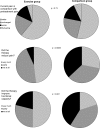Long-term effects of supervised physical training in secondary prevention of low back pain
- PMID: 15714351
- PMCID: PMC3489242
- DOI: 10.1007/s00586-004-0873-3
Long-term effects of supervised physical training in secondary prevention of low back pain
Abstract
Background and objectives: In the last few years, several studies have focused on short-term treatment effects of exercise therapy. However, there is a lack of knowledge concerning the long-term treatment effects recorded after several years. Hence, this study was performed to investigate the short- and long-term effects of supervised physical training on functional ability, self-rated pain and disability in secondary prevention of low back pain.
Methods: One hundred and eighty-three hospital employees with chronic low back pain were randomly assigned either to back school (comparison group), or three-months supervised physical training including a back school (exercise group). Various measurements of functional ability were performed and subjects completed questionnaires on self-rated pain, disability, and general well-being before treatment, immediately after intervention, and at six-months follow-up. At one-year and at ten-years follow-up participants evaluated treatment effectiveness.
Results: Out of 183 employees, 148 completed the program. Participation at follow-ups ranged from 66 to 96%. Supervised physical training significantly improved muscular endurance and isokinetic strength during a six-months follow-up, and effectively decreased self-rated pain and disability during a one-year follow-up. At ten-years follow-up the subjects' assessment of the effectiveness of treatment was significantly better in the exercise group.
Conclusions: Supervised physical training effectively improved functional capacity and decreased LBP and disability up to one-year follow-up. The subjects' positive evaluation of the treatment effect at ten-years follow-up suggests a long-term benefit of training.
Figures


Comment on
-
Reviewer's Comment regarding: "Long-term effects of supervised physical training in secondary prevention of low back pain" (by I. Maul et al.).Eur Spine J. 2005 Aug;14(6):612. doi: 10.1007/s00586-005-0907-5. Epub 2005 Apr 29. Eur Spine J. 2005. PMID: 15864665 Free PMC article. No abstract available.
References
-
- Antonovsky A. Unraveling the mystery of health. How people manage stress and stay well. San Francisco: Jossey-Bass; 1987.
-
- Biering-Soerensen F. Physical measurement as risk indicators for low-back trouble over a one-year period. Spine. 1984;9:106–119. - PubMed
-
- Bigos S, Bowyer O, Braen G, et al. Acute low back problems in adults. Clinical practice guideline No. 14. AHCPR Publication No. 95-0642. Rockville: Public Health Service; 1995.
Publication types
MeSH terms
LinkOut - more resources
Full Text Sources
Medical
Miscellaneous

